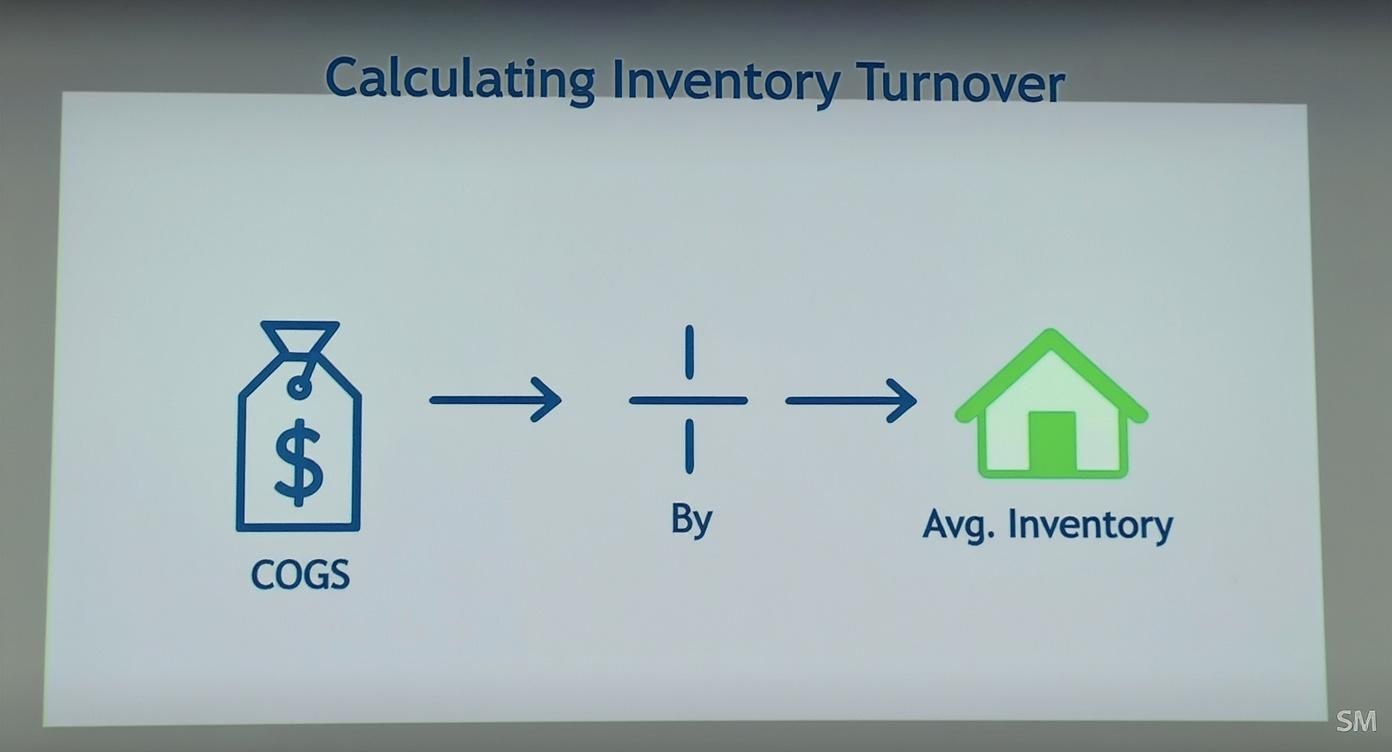Think of your inventory like cash, but instead of sitting in a bank, it's sitting on your warehouse shelves. Inventory turnover is the metric that tells you how fast you're turning that "shelved cash" back into real money in your account.
In simple terms, it measures how many times your business sells through its entire stock of goods in a specific period. It’s a key indicator of your business’s pulse.

Understanding inventory turnover isn't just for the accountants. It gives you a direct, unfiltered look into how healthy your operations really are. This isn't some dry, theoretical number; it's a vital sign that shows how well you're managing one of your biggest and most expensive assets.
A high turnover rate is a great sign. It means your sales are strong and you're buying the right amount of the right products. On the flip side, a low turnover rate can be a red flag, pointing to some serious issues lurking under the surface.
This metric is calculated by dividing your Cost of Goods Sold (COGS) by your average inventory value. For instance, if your business had $800,000 in COGS for the year and held an average inventory of $200,000, your turnover ratio would be 4. You sold through and replaced your entire inventory four times that year.
Picture your business as a busy restaurant kitchen. The best kitchens get fresh ingredients delivered, quickly turn them into meals for happy customers, and get paid. That smooth, efficient flow keeps waste down and profits up.
But what happens if those ingredients sit around too long? They spoil. It's the exact same story with your inventory. Unsold products become obsolete, tie up your cash, and rack up storage costs.
Getting a handle on your turnover directly impacts the core of your business:
At its core, inventory turnover is a measure of efficiency. It tells you if your products are in demand and if your supply chain is aligned with that demand.
Ultimately, this single number tells a powerful story about how fast your products are selling and how effective your inventory strategy is. When you monitor it closely, you can stop reacting to problems and start making proactive decisions that boost your profitability and make your entire operation stronger.
For a deeper dive into the numbers, you can check out our complete definition of inventory turnover.
Figuring out the math behind your inventory turnover is way simpler than it sounds. The core formula is pretty straightforward, and it only needs two key numbers you can pull straight from your financial statements.
Once you know what those numbers mean, running this calculation stops feeling like an accounting chore and starts feeling like you've unlocked a powerful new business insight.
The formula is: Inventory Turnover = Cost of Goods Sold / Average Inventory
Let's break down what each of those pieces really means.
First up, you need your Cost of Goods Sold, or COGS. Think of this as the direct cost of everything you sold during a specific time frame. It’s the money you spent on raw materials, direct labor, and manufacturing—but it doesn’t include things like your marketing budget or office salaries.
You’ll find your COGS listed right on your company’s income statement. It’s a standard line item that gives you a clean look at what your inventory cost before you marked it up for sale. Using COGS is critical because it ensures you're comparing apples to apples—valuing both the goods you sold and the inventory you're holding at their actual cost.
Next, you need to pin down your Average Inventory. It’s tempting to just grab a single day’s inventory value and call it good, but that can really throw off your numbers. What if you take that snapshot right after a huge shipment arrived, or the day after a massive sale cleared you out? Your calculation would be completely skewed.
To get a much more accurate and balanced view, you need to calculate an average over the entire period you're measuring. Here's the simple formula for that:
Average Inventory = (Beginning Inventory + Ending Inventory) / 2
You can find both of these numbers on your company's balance sheet. If you want to dive deeper into how inventory is valued, our guide to mastering inventory valuation methods for better accounting is a great place to start.
Key Takeaway: Using an average inventory value smooths out the natural peaks and valleys in your stock levels. This gives you a far more reliable baseline for your turnover calculation.
Let's see this in action with a couple of different business scenarios.
Example 1: A Local Coffee Shop
Imagine a local coffee shop wants to figure out its annual inventory turnover for all its coffee beans and pastries.
First, they need to calculate their average inventory for the year:
($20,000 + $10,000) / 2 = $15,000
Now, they can plug that into the main formula:
$150,000 (COGS) / $15,000 (Average Inventory) = 10
This means the coffee shop completely sold and replaced its entire inventory 10 times over the course of the year.
Figuring out your inventory turnover ratio is the easy part. The real magic happens when you understand the story that number is telling you about your business. A single metric can tell you if your sales are humming along or if your cash is stuck collecting dust on warehouse shelves. Learning to read that story is the key to making smarter decisions.
At first glance, a high ratio feels like a win—it usually signals strong sales and means you're moving product efficiently. But if it gets too high, it can be a red flag. This might mean you're understocking, which leads to stockouts, lost sales, and frustrated customers who might not come back.
On the flip side, a low ratio often points to some serious friction in your operations. It suggests you’re sitting on way too much inventory, which ties up capital that could be used for marketing, product development, or just about anything else. It also ramps up the risk of products becoming obsolete or damaged and drives up holding costs for things like storage and insurance.
The perfect inventory turnover ratio isn't a universal number; it’s all about finding the right balance for your specific business and industry. Think of it like the tachometer in a car—you don't want to be redlining the engine, but you also don't want to be stalling out. Your goal is to find that sweet spot that maximizes sales without constantly running the risk of selling out of popular items.
The basic formula, shown below, is your Cost of Goods Sold divided by your Average Inventory. It’s a straightforward calculation that gets to the heart of how efficiently you manage your stock.

This simple flow shows you the two core ingredients you need to figure out how many times you sell and replace your entire stock over a period.
To make sense of your number, here’s a quick guide to what high, low, and ideal ratios typically signal.
As you can see, every ratio level has its trade-offs. The key is to understand what each one means in the context of your business goals and market conditions.
Key Insight: Neither a very high nor a very low turnover is automatically good or bad. Context is everything. A high ratio is great until you run out of your best-selling product during peak season. A low ratio is a problem unless you’re intentionally stocking up for a huge upcoming promotion.
To make your turnover ratio even more useful, you can translate it into a number that’s much easier to visualize: Days Sales of Inventory (DSI). This metric tells you, in plain terms, the average number of days it takes to sell through your inventory. It takes the abstract ratio and gives you a concrete timeline.
Calculating DSI is simple:
365 Days / Your Inventory Turnover Ratio = Days Sales of Inventory
For example, if your inventory turnover ratio is 8, your DSI would be 45.6 days (365 / 8). This means that, on average, an item sits on your shelf for about 46 days before a customer buys it. This gives you a tangible timeframe to work with for planning purchase orders, cash flow, and marketing campaigns.
If you want to dive deeper into this metric, check out our guide to Days on Hand Inventory calculation.
So, you’ve calculated your inventory turnover ratio. Now comes the big question every business owner asks: "Is this number any good?"
The honest answer? It depends. A “good” inventory turnover isn’t a universal number—it’s entirely dictated by the industry you’re in.
Trying to measure your ratio against some generic standard is like comparing a speedboat to a cargo ship. They’re both great at what they do, but they operate at completely different speeds for very different reasons. Your real goal is to benchmark your performance against businesses navigating the same waters as you.
Let's make this real. Think about a local grocery store. Their inventory—fresh produce, milk, bread—is highly perishable. They have to sell through it fast to avoid spoilage and waste. A slow turnover would be an absolute disaster, leading to huge losses.
Now, pivot to a high-end furniture store or a luxury car dealership. Their products are big-ticket items with a much longer, more considered sales cycle. A customer might take months to decide on a purchase. For these businesses, a low turnover ratio isn't just normal; it's expected. Forcing a high turnover would probably mean slashing prices and gutting their profit margins.
These two examples drive home the single most important rule of inventory turnover: what works for one industry is a recipe for failure in another. Several key factors create these massive differences:
Because every industry plays by different rules, comparing your numbers to relevant benchmarks is the only way to get a true sense of your performance. The retail sector alone shows just how wide the spectrum is.
Grocery stores, for example, often have an incredibly high turnover, sometimes turning their inventory 15 to 30 times a year. On the other end, automotive dealerships might see a ratio below 5. The broader retail sector often lands around an average of 8.8, which blends all these different product types together. For a deeper dive, you can discover industry-specific insights at Netstock.
By focusing on your specific industry, you can set realistic goals, accurately gauge your performance against direct competitors, and develop strategies that are truly relevant to your business model.

So, you've got a handle on what inventory turnover means and you’ve calculated your ratio. Now what? The next step is turning that number into action. Think of a low turnover ratio not as a failing grade, but as a clear signal that it's time to adjust your strategy.
Improving your turnover is about more than just a number on a spreadsheet. It means freeing up cash, cutting down on waste, and making your entire business more agile and profitable. Luckily, there are a handful of powerful, field-tested methods you can use to get your inventory moving. These tactics range from smarter forecasting to strategic promotions, all designed to fine-tune how you buy, manage, and sell your products.
The absolute best way to stop overstocking is to get better at predicting what your customers will want and when they'll want it. Accurate demand forecasting is the bedrock of smart inventory management. Stop relying on guesswork. Instead, dig into your historical sales data, look at seasonal trends, and factor in upcoming promotions to make much more informed buying decisions.
Modern forecasting isn't about gazing into a crystal ball; it's about using the data you already have to see what's coming. This simple shift stops you from tying up precious capital in products that are just going to collect dust on a shelf.
If a few specific products are dragging down your turnover rate, smart pricing can be a powerful lever to pull. This doesn't mean you have to slash prices across the board. Instead, try a few targeted approaches:
These tactics do more than just clear out slow-moving inventory. They can also create a welcome surge in sales and even attract some new customers.
A well-planned promotion can do more than just bump up your inventory turnover. It can liquidate dead stock, turning a potential loss into immediate cash flow that you can reinvest in products that actually sell.
Let's be honest: not all of your inventory is created equal. ABC analysis is a straightforward way to categorize your products based on their value and how often they sell. This lets you focus your energy where it will have the biggest impact.
By focusing your attention on your A-Items, you ensure your most profitable products are always available, which directly boosts sales and improves your overall turnover ratio. This kind of systematic approach is one of the essential inventory management best practices that can completely transform your operations.
Reducing the number of C-Items you hold also directly helps your bottom line by slashing carrying expenses. To get a better grip on those figures, you can learn more about how to calculate inventory holding costs in our detailed guide. When you partner with a 3PL like Simpl Fulfillment, we help manage this process for you, ensuring your inventory is handled efficiently to keep costs low and turnover high.
Even after you get the hang of the basics, a few key questions always seem to pop up when business owners start digging into their inventory turnover. It's a powerful number, but it can feel a little abstract at first. Let's clear up some of the most common questions that come up time and time again.
Getting these details right is what turns a simple calculation into a powerful tool for making smarter business decisions.
Yes, absolutely. While a high ratio usually points to healthy sales and efficiency, a number that’s too high can be a major red flag. It’s often a sign of under-stocking, and that comes with its own set of serious problems.
If you’re constantly selling out of your most popular products, you aren’t just losing out on that one sale. You’re creating frustrated customers who might just head over to a competitor—and stay there. It also secretly drives up your costs, since you’re placing more frequent, smaller orders and racking up extra shipping fees.
The goal isn’t to chase the highest number possible. It's about finding that sweet spot where inventory moves efficiently without ever putting you at risk of missing a sale or letting a customer down.
This really depends on your industry and how fast your products sell. An annual calculation is fine for year-end financial reports, but it’s way too slow to give you any real-time insight for running your business. That’s like only checking your car’s oil once a year—you'd miss a lot of potential trouble.
For most businesses, calculating it quarterly or monthly is much more useful. This rhythm lets you spot trends, react to what’s happening in the market, and fix small issues before they snowball into big problems.
And if you're in a fast-moving industry like fashion or electronics? Monthly is a must. Seasonal trends can make or break your entire year, and monthly tracking gives you the agility you need to adjust your buying and avoid getting stuck with obsolete stock.
Always, always use Cost of Goods Sold (COGS). This is the non-negotiable standard across the board, and for a very good reason: it keeps the comparison honest.
Think about it: both your inventory value on the balance sheet and your COGS on the income statement are measured at cost. Neither one includes your profit margin. If you were to use revenue (your sales price) in the formula, you’d be dividing a number with your markup baked in by a number without it.
That simple mistake would instantly and artificially inflate your turnover ratio, giving you a completely distorted picture of how efficient you really are. Sticking with COGS ensures your numbers are accurate, consistent, and can be measured against real industry benchmarks.
Optimizing your inventory turnover is a continuous process of refinement. At Simpl Fulfillment, we provide the tools and expertise to make it happen. Our advanced fulfillment solutions and real-time inventory visibility help you strike the perfect balance between lean operations and meeting customer demand. Take control of your inventory and fuel your brand's growth with us.